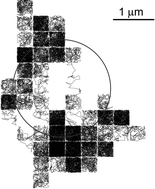Theory of fluorescence correlation spectroscopy at variable observation area for two-dimensional diffusion on a meshgrid
Abstract
It has recently been proposed, with the help of numerical investigations, that

a Laboratoire de Physique Théorique, Université de Toulouse, CNRS, 118, route de Narbonne, 31062 Toulouse cedex, France
b Institut de Pharmacologie et Biologie Structurale, Université de Toulouse, CNRS, 205, route de Narbonne, 31077 Toulouse cedex, France
It has recently been proposed, with the help of numerical investigations, that

 Please wait while we load your content...
Something went wrong. Try again?
Please wait while we load your content...
Something went wrong. Try again?
N. Destainville, Soft Matter, 2008, 4, 1288 DOI: 10.1039/B718583A
To request permission to reproduce material from this article, please go to the Copyright Clearance Center request page.
If you are an author contributing to an RSC publication, you do not need to request permission provided correct acknowledgement is given.
If you are the author of this article, you do not need to request permission to reproduce figures and diagrams provided correct acknowledgement is given. If you want to reproduce the whole article in a third-party publication (excluding your thesis/dissertation for which permission is not required) please go to the Copyright Clearance Center request page.
Read more about how to correctly acknowledge RSC content.
 Fetching data from CrossRef.
Fetching data from CrossRef.
This may take some time to load.
Loading related content
